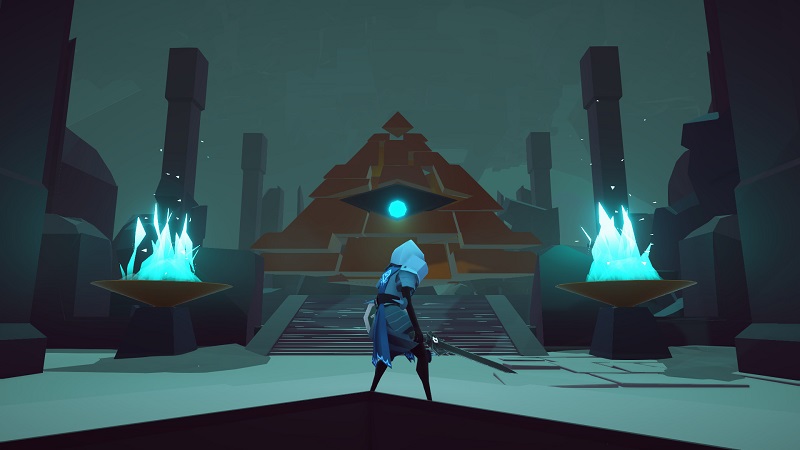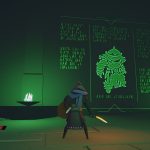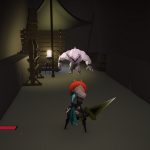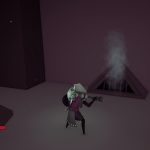Our experience with Necropolis (sometimes subtitled ‘A Diabolical Dungeon Dive’) reads like a bad love story. It started with hope and longing, then love that quickly turned to hate.
So gather around and let us tell you this sad tale.
A somewhat under-marketed game, we first came across Necropolis while trawling through the Steam Summer Sale in the hope of finding a decent new roguelike/lite. This year has been great for the genre as we’ve already received two of them in the form of Enter the Dungeon and Darkest Dungeon.
Necropolis promised Dark Souls-esque combat with drop in/ drop out co-op complete with those rogue elements we’ve come to love/hate so much. It’s a lot to ask of a game, aping one of the most popular series in recent memories and adding the complex rogue parts too.
Once you start playing the game the Souls comparisons don’t stop. While the keyboard and mouse controls are all right, we found it easier to play the game with a control-pad and damned if the button layout isn’t a carbon copy of Dark Souls.
Combat works in much the same way. You’ll need to keep your shield up to survive while you strategically plan your strikes. Your healing items and potions take a good while to activate you’re defenceless while they do. You’ll need to dodge a lot and doing so eats away at your stamina bar, which you’ll need to keep a constant eye on.
Necropolis does differ from the Souls games in some aspects, though, and these deviations are wrapped up in the game’s rogue elements. For example, Necropolis has a crafting mechanic; while you won’t be able to make new weapons or armour (or a house, this isn’t Minecraft), you’ll need to make basic healing items and potions from raw ingredients dropped by dead enemies.
The healing items are especially important. Not for health per se, but for your stamina. Actions like heavy attacks not only deplete stamina, but permanently reduce it until you heal up. In fact, you’ll probably be using “healing” items to regain stamina more than health.
Potions, on the other hand, usually give you some kind of buff.
This was the honeymoon phase of our time with Necropolis. We enjoyed the combat, despite it being far removed from the complexity and subtlety of Souls. We even liked the flat art style which makes for a beautiful game.
That having been said, the sparse aesthetic makes the environments look incredibly similar, and the levels aren’t generated well. In one play session we spent in excess of 90 minutes trying to find the exit in level 2. Granted, we have terrible navigation skills, but either the level was horribly put together (made worse by the art-style) or it just didn’t generate an exit. Oh and the lack of an in-game map doesn’t help much either.
All the while we were harassed by endlessly-generating enemies; we became so accustomed to dispatching then that we soon became bored.
Trudging through this endless hell we, unfortunately, had time to appreciate more of the environment’s shortcomings. While the levels are reasonably large, they are sparsely occupied by both enemies and objects. The devs did not spend enough time making sure there was enough to do on each section of the level.
Progression in the game has its own set of problems. At the start of each level the dungeon master (a speaking, one-eyed pyramid known as the ‘Brazen Head’) will issue challenges. Completing them grants you tokens, which you can exchange for a high-tier unlock at the start of each level or a buff in the form of a collectible book called a Codex.
These challenges are completely random, which makes a lot of them impossible to achieve initially. For example, ‘killing 10 Clockwork Knights’ sounds easy enough, but not when the challenge is offered on level 1 and they don’t appear until much later in the game.
Furthermore there are aspects and in-game features that the devs leave unexplained. We spent two hours on a single run, forgoing the unlocks to farm tokens. With our princely sum of 15 tokens we bought a codex that we thought would give us infinite stamina. It didn’t. Hell, we still don’t know what it does and the game won’t tell us.
Progression is a key element of all roguelikes. Each run and each death is supposed to keep you playing. Necropolis completely spits in the face of this idea. Instead if you’ve played five minutes of this game, you’ve seen everything it has to offer you.
Beyond those deal-breakers, Necropolis is peppered with a host of irritating nuisances.
The equipment system is a prime example; players have to find new equipment since they can’t craft their own and the variety of weapons they’ll come across is sparse to say the least. The game is so stingy with these items, so unwilling to let players have fun with them, that you’ll spend hours grinding away with the same basic weapons, the promise of new and better equipment remaining a mere pipe dream.
If you ever manage to come across a new armour set or weapon, you have no real way to see what it does or how it compares to other weapons. While there is a tier system in place, there are zero other stats.
Other small, ultimately grating problems include the terrible “humour” which is painfully inserted into what could have been a more stoic, enjoyable narrative. Then there’s the lack of music and sound effects which feed into the problematic combat and even the inventory system which is hopelessly limited.
Can co-op save the day?
As online co-op is a much touted feature of this game, the developers were kind enough to provide us with four game keys to test it out ourselves. Unfortunately we have to report that the online experience was one of the worst we’ve experienced in ages.
Joining games took absolute forever, input lag was infuriating and the in-game enemies acted dumbfounded by our presence in the game.
Games media throw around the term “unplayable” a lot and mostly unfairly, but it’s the only term we can use here. Using regular broadband connections in South Africa will not get you anything resembling a playable game.
The only success we had was when we played in the same room on an extremely fast LTE connection, which three players were all connected to. Looking past the fact that this was tantamount to a LAN, we found more problems.
One core element of roguelikes is the permadeath. When you die the game ends and that’s it. That’s why the progression system is so important and it’s what makes this genre compelling. In co-op, that doesn’t exist anymore. As long as one player is standing the team can be infinitely resurrected at half health.
Conclusion
Necropolis is frustrating in the worst kind of way, not because of the difficulty trumpeted in the game’s marketing, but because of its wasted potential.
Beneath a litany of problems, there is a decent game trying desperately to claw its way out. Maybe with several massive patches, updates and expansions (or a full sequel) Necropolis can be the game it was supposed to. But, until that happens, we can’t recommend it at all.
Like adoptive parents; we’re not angry, Necropolis, we’re just disappointed.
Review platform: PC | Game code provided by the developer







